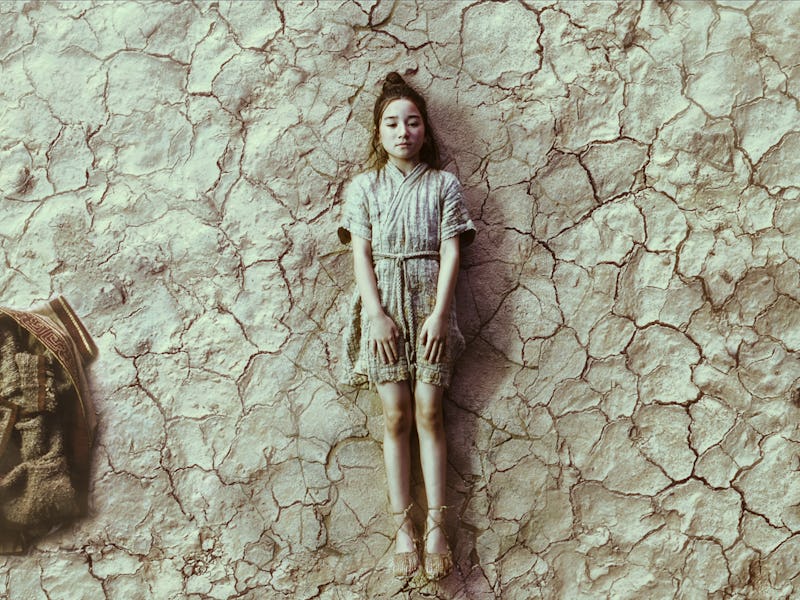3 Body Problem’s VR World Is More Low-Tech Than It Looks
How do you create a VR world that is both convincing and also unreal? 3 Body’s Derek Tsang has the answer.

In the world of 3 Body Problem, the title refers to two things: the complex physics problem that involves a planet that shares an orbit with three stars, and a VR game that characters play called “3 Body.” In Cixin Liu’s first book in the Three-Body series, Wang Miao finds himself playing the secret VR game, which is eventually revealed to be a recruitment tool for humans working with distant aliens. In the new Netflix show, the VR world of “3 Body” comes to life in a very specific way. When Jin (Jess Hong) and Jack (John Bradley) enter this VR world, it’s simultaneously extremely convincing and intentionally uncanny.
“We didn’t shoot outside, and we didn’t use the Volume.”
To bring this mind-bending VR world to life, the director of the first two episodes of 3 Body Problem — Derek Tsang — had to thread a strange aesthetic needle. We have to believe the characters are overwhelmed by the immersive experience, but we also need to know this isn’t supposed to literally be another planet. To make this specific feeling land, Tsang tells Inverse that he had to go more low-tech than you might think.
Mild spoilers for 3 Body Problem ahead.
“We didn’t shoot outside, and we didn’t use the Volume,” Tsang says, referencing the most well-known AR Wall technology. “It was a stage, and I have to give credit to my DP Jonathan Freeman, for figuring out this really ingenious way of building this stage. It’s like a more impromptu Volume stage.”
Director Derek Tsang looks on as Jess Hong films a pivotal scene in the VR world of “3 Body.” If you look closely you can see that the opaque background behind them is actually made up of individual screens, fused together.
Tsang explains the 3 Body Problem production did consider filming on the Volume, but in the end, time constraints and aesthetic choices led them in a different direction. “The essence of the game is really about the movement of the suns, and we really needed to mimic that in that gaming world,” Tsang says. “For the background environment, the VFX can take care of that. But we needed to see light reacting on the actors. We needed to do all of that in-camera.”
The solution was to create a kind of “low-rent AR wall,” which ended up becoming a stage made of “thousands and thousands of LED panels.” Like the high-tech/unreal feeling of the game itself, the set constructed for these sequences is a bit of a throwback from more immersive AR walls used in other sci-fi shows.
“It was from the bottom all the way to the ceiling,” Tsang explains. “It was surrounding us. But we’d have panels that can control where the lights start and move so we can kind of mimic that sun rising and falling. It was very eye-opening for me.”
Jess Hong as Jin on the unique set for 3 Body Problem.
Despite the very specific and challenging ways that certain 3 Body scenes had to be shot, Tsang was also responsible for the contemporary action in the first two episodes as well as the flashbacks to the 1960s in China. If these shifts between timelines sometimes feel like you’re watching two different shows, Tsang says that was intentional.
“It was a conscious attempt to make the look different,” Tsang says. “In the flashback sequences, it’s mostly very cold weather. So it’s more grayish. We also wanted to capture the heightened emotional state in the China ‘60s part. So there's a lot of handheld, a lot of very more raw camera work in terms of that. But then when we come back to the contemporary time, it's more of a thriller way of approaching things, that thriller aspect, that mystery aspect of it that draws the audience into the story.”
“It was a conscious attempt to make the look different.”
Appropriately, thanks to Tsang’s efforts, 3 Body Problem feels like it takes place in three different worlds: the past, the present, and the allegorical VR world of the alien San-Ti. Balancing all of those aesthetics is clearly tricky, but Tsang emphasizes that it’s all about character. In the show, the solution to the “3 Body” game isn’t to figure out the physics problem but to preserve the people. And making the show was very much the same.
“I think it’s just a moving human story about how we as human beings react when we're thrown into such an existential threat,” Tsang says. “Aside from all the amazing scientific science fiction ideas in the book, for me, it’s always about how these different individuals react. That is most attractive, most touching for me. It’s a human story.”